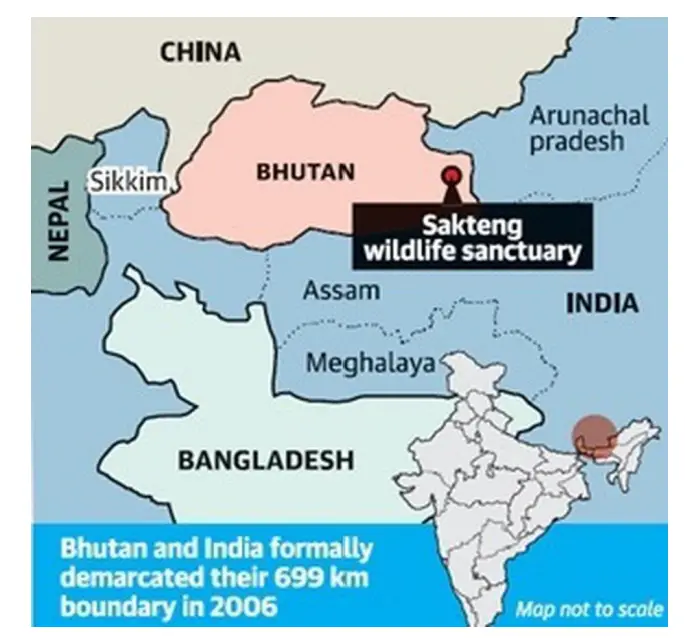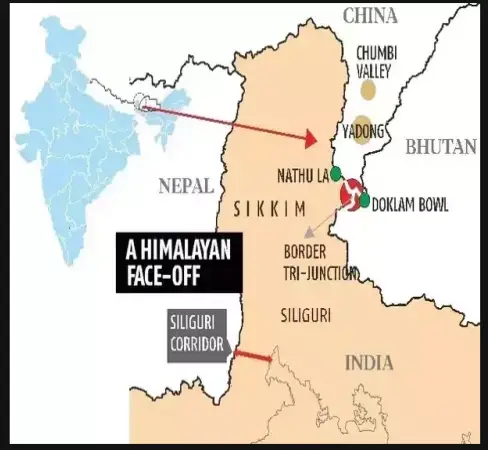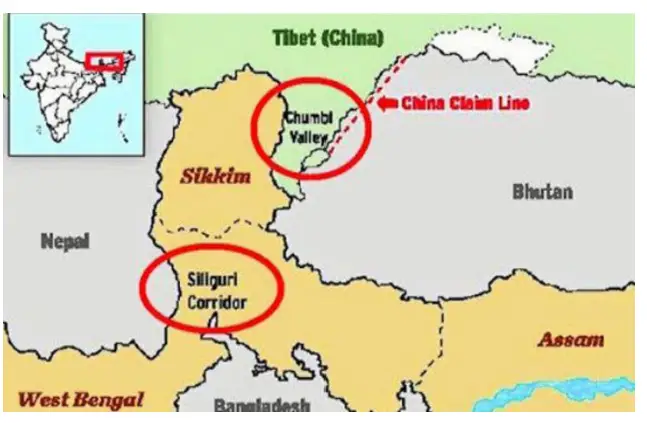The diplomatic relationship between India and its neighbor, Bhutan, stands as a noteworthy example when examining the interactions between neighboring nations within the realm of International Relations. Typically, neighboring nations often grapple with disputes and tend to maintain a state of conflict or, at best, manage their relations without much warmth.
In stark contrast, the case of India-Bhutan portrays a unique and warm camaraderie. This warmth is rooted in their shared history, common culture, and mutual interests, which serve as the foundations for their strong and harmonious bilateral relationship.

2020 Feb Document by Indian Ministry of External Affairs
2023 March Document by Indian Ministry of External Affairs
INDIA-BHUTAN RELATIONS
Geographical Proximity
These two nations, India and Bhutan, are linked by a 699-kilometer border. The Indian states that share their borders with Bhutan include Arunachal Pradesh, Assam, Sikkim, and West Bengal. Notably, both countries also share the ecological treasure of Manas National Park, which is located in Assam.
Bhutan’s Geographical Context
Bhutan is a landlocked nation nestled between India and China, with the grand Himalayan Mountains as a prominent natural feature of the country’s landscape.
High-Level Diplomatic Engagement
Recent years have witnessed significant high-level visits between the two countries, including the visit of Prime Minister Narendra Modi to Bhutan in August 2019.
Tourism Dynamics
In February 2020, Bhutan introduced a ‘Sustainable Development Fee’ of USD 17 per day for Indian tourists visiting and staying in the Western districts of Bhutan. This move has raised questions regarding Bhutan’s efforts to manage the influx of Indian tourists.
In this module, we will delve into this issue along with other key factors that shape Indo-Bhutanese relations.
Historical Ties
Bhutan’s historical ties with India are deeply rooted. Before India gained independence, Bhutan was under the protection of the British Empire. Following India’s independence, a new pact was formed in 1949, officially known as the India-Bhutan Treaty of Friendship and Cooperation.
Sovereignty and Cooperation
This treaty had significant provisions, including India’s commitment not to meddle in Bhutan’s domestic affairs and Bhutan’s pledge not to import arms and ammunition without India’s counsel (Article 2 of the Treaty). Additionally, Bhutan sought India’s guidance on matters related to its foreign policy. Over the years, India has been a vital source of development assistance for Bhutan, ensuring its protection against external threats.
Milestone Diplomatic Relations
In 2018, the Golden Jubilee marked the celebration of fifty years of formal diplomatic relations between India and Bhutan.
Evolving Relations
While there have been some changes in this historical context, the relationship between these two nations continues to evolve and grow stronger.
In the upcoming sections, we will explore the various dimensions of this enduring cooperation.
AREAS FOR COOPERATION
A) Economic Cooperation and Development Assistance
India and Bhutan have established robust economic cooperation, with bilateral trade between the two nations amounting to approximately Rs 4300 crores in the first half of 2018. India allows duty-free transit of goods exported by Bhutan to other countries. Moreover, both nations are collaborating on vital connectivity projects, including a railway link connecting Mujnai in West Bengal to Nyoenpaling in Bhutan. The BBIN (Bangladesh-Bhutan-India-Nepal) road connectivity project is another significant endeavor, although Bhutan’s Parliament initially declined to ratify this agreement due to sustainability and traffic concerns.
In the 18th SAARC summit of 2014, the SAARC nations could not sign a Motor Vehicles Agreement (MVA) due to Pakistan’s refusal. Subsequently, the BBIN agreement was established in 2015 to facilitate the movement of passengers, personnel, and cargo among India, Bhutan, Bangladesh, and Nepal. In 2015, cargo was successfully transported from Kolkata to Agartala via Bangladesh, marking the operationalization of the project.
1. Hydro-electric Power Collaboration
One of the prominent aspects of collaboration between India and Bhutan is hydro-electric power. India has committed to developing hydro-electric projects in Bhutan, aiming to harness approximately 10,000 MW of electricity. This partnership began in 2006 with the signing of the Agreement on Cooperation in the Field of Hydro-electric Power. India has already completed projects like Tala, Chukha, and Kurichhu, with electricity being exported to India and integrated into the national grid.
India recently concluded the Mangdechhu hydro-electric project, boasting 720 MW capacity, and is in the process of finishing the Punatsangchhu 1 and 2 projects. Furthermore, a pact was signed to construct the Kholongchhu hydro-electric power project, a 600 MW endeavor situated in Eastern Bhutan. This collaboration serves the mutual interests of both nations and contributes to India’s energy security.
The implementation of India’s guidelines on Cross Border Trade of Electricity in 2016, which concerned the costs and maintenance of these projects, introduced some delays. However, India revised these guidelines following negotiations with Bhutan.
2. Renewable Energy and Investment
India’s emphasis on renewable energy, particularly solar power, could influence the bilateral relationship, depending on the economic landscape in the future. India is also the most significant foreign investor in Bhutan, with the two countries agreeing on a total of 73 projects as of 2018.
In terms of development assistance, India played a pivotal role by funding Bhutan’s entire first 5-year plan in 1961. Presently, India is extending assistance of Rs 4500 crores for Bhutan’s 12th 5-year plan, spanning from 2018 to 2023. Under this plan, Bhutan is implementing 51 Large and Intermediate projects and over 350 Small Development Projects (SDP).
Bhutan hosts a ground facility for the GSLV-09 satellite, also known as the South Asian satellite, which bolsters communication facilities for SAARC nations. All SAARC members are involved in this initiative except Pakistan.
The RuPay debit card, developed by the National Payment Corporation of India, has been extended to Bhutan, further fostering economic ties between the two nations.
3. Exploring New Frontiers
India and Bhutan are continually seeking new areas for cooperation. One potential avenue is digital transformation, including the realm of Artificial Intelligence. This diversified approach is essential for further strengthening their bilateral relationship.
B) Defence and Strategic Cooperation
To comprehend Bhutan’s significance to India’s national interests, let’s delve into various aspects of their strategic cooperation:

1. Border Concerns and Insurgency Threat
Initially, the shared border was a cause for concern due to the forested areas serving as a passage for insurgents from North-Eastern groups to infiltrate Bhutan, where they found refuge. To address this issue, India engaged Bhutan in discussions.
In 2003-04, Bhutan conducted ‘Operation All Clear’ to eliminate insurgent groups like the United Liberation Front of Assam (ULFA), the National Democratic Front of Bodoland (NDFB), and the Kamtapur Liberation Organization (KLO). This operation targeted over 30 militant camps and resulted in the neutralization of more than 650 terrorists.
2. China’s Role in the Equation
The presence of China profoundly influences the strategic cooperation between India and Bhutan. In 2017, a dispute in the Doklam plateau, a region at the tri-junction of India (Sikkim), Bhutan, and China, unfolded. India effectively countered Chinese threats and a temporary resolution was achieved.
However, in 2020, the Sakteng Wildlife Sanctuary, situated near the Indian state of Arunachal Pradesh, garnered attention. During a Global Environment Facility (GEF) meeting, a US-based environmental project financing body, China raised objections to project funding within the sanctuary’s Eastern Bhutanese region. Nevertheless, these objections were dismissed.
India closely monitors developments in areas close to the India-Bhutan-China tri-junction. The Siliguri Corridor is particularly concerning, often called India’s “chicken neck.” China could seize this corridor in a conflict between India and China, severing the connection between India’s mainland and the North-Eastern regions.

3. India’s Diplomatic and Policy Engagement
Bhutan represents a synergy of India’s “Neighbourhood First” and its “Act East” policies. Both countries collaborate across multilateral forums, such as BIMSTEC and SAARC.
Notably, Bhutan is India’s sole neighbouring nation that lacks diplomatic relations with China and refrains from participating in China’s One Belt One Road (OBOR) initiative.
China-Bhutan Border Dispute
The border dispute between Bhutan and China has seen 24 rounds of negotiations from 1984 to 2016. Bhutan contends that the dispute primarily pertains to the Western sector, encompassing the Dokhlam Plateau and the northern section, covering areas like Pasamlung and Jakarlung.
China has a history of asserting new claims, and its aggressive actions in various global regions, including its immediate neighbourhood, are sources of concern. In the case of Bhutan, the Eastern section was not part of the 24 rounds of negotiations between the two nations.
Renowned author Priyajit Debsarkar emphasizes the need for India, with its formidable power, to safeguard Bhutan at all costs, given China’s extensive expansionist agenda.
C) Cultural Relations
Cultural ties form another pivotal dimension of collaboration between these two nations:
1. Guru Padmasambhava’s Legacy
The esteemed Guru Padmasambhava, who embarked from India to Bhutan, played a significant role in disseminating Buddhism within Bhutan’s borders. His influence remains deeply ingrained in Bhutan’s cultural fabric.
2. Promotion of Buddhist Tourism
Bhutanese individuals often embark on journeys to explore various Buddhist pilgrimage sites in India. India can further enhance cultural exchange by integrating these sacred Buddhist sites in Bhutan into the Swadesh Darshan scheme, thereby fostering joint tourism endeavors.
3. People-to-People Bonds
India serves as a preferred destination for Bhutanese citizens aspiring to pursue education and employment opportunities. This close people-to-people connection strengthens the cultural links between both countries.
4. Resident Indian Community in Bhutan
Around 60,000 Indian nationals have made Bhutan their home, predominantly engaged in activities related to hydroelectric power construction and road infrastructure development.
5. Daily Cross-Border Interaction
Furthermore, daily, a substantial number of approximately 8,000 to 10,000 laborers commute between Bhutan and neighboring border towns, contributing to the dynamic cross-border connection.
Evolving Dynamics of Relations
In recent years, the relationship between India and Bhutan has undergone notable transformations compared to its inception in 1949 when the India-Bhutan Treaty of Friendship and Cooperation was established.
1. Socio-Economic Evolution
Both countries have witnessed significant shifts in their socio-economic conditions. India has emerged as a global powerhouse, while Bhutan is actively advancing along the development path.
2. 2007 Treaty Amendment
Recognizing these pivotal developments, in 2007, the two nations amended the original 1949 treaty by revising particular critical articles. For instance, Article 2, which previously restricted Bhutan from importing arms and ammunition, was modified to permit such imports as long as they do not conflict with India’s interests.
This astute recognition of the evolving nature of their relationship has served as a cornerstone in preserving their friendship and collaboration.
3. Embracing Change with Nepal
India should also acknowledge similar shifts in its treaty with Nepal, recognizing the need to embrace and adapt to evolving dynamics between the two countries.
4. Exploring New Frontiers of Cooperation
It remains imperative for India to explore new avenues of cooperation with Bhutan continually. For instance, establishing ISRO’s ground station in Bhutan is a positive step. This station will greatly assist Bhutan in disseminating vital weather-related information to its remote regions.
5. China’s Growing Influence
China has been actively enticing Bhutan to establish diplomatic relations, leveraging its substantial economic influence to gain favour. This is a concern for both India and Bhutan, who share apprehensions about the safety of their border in relation to China. Collaboration to maintain militant-free border areas is of paramount importance.
6. Adapting to a Changing World
India should adopt a more contemporary approach in its interactions with Bhutan, shedding the outdated “big brotherly” stance and engaging with Bhutan on terms that align with the evolving dynamics of the world.
